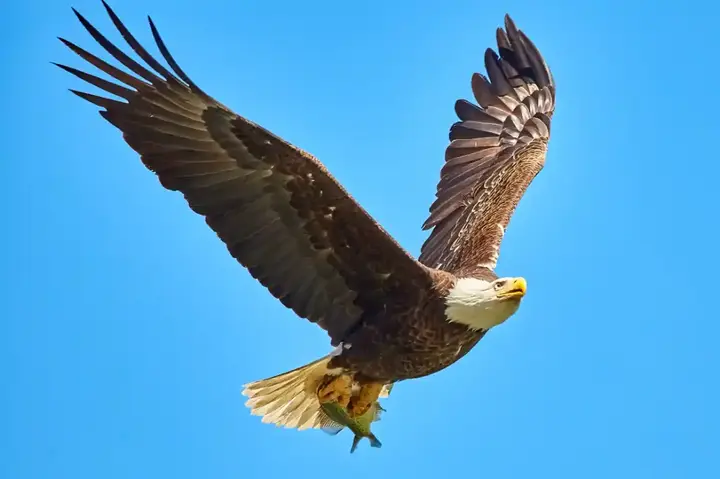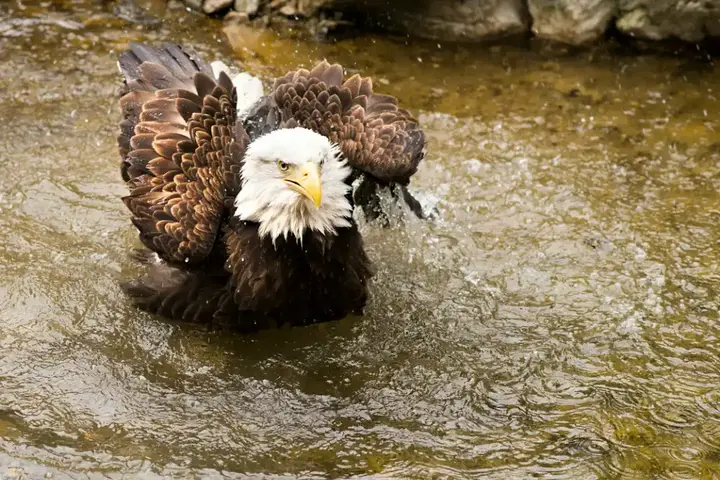Top ten facts about the eagle

Known for their huge wings, terrifying claws and piercing gaze, eagles are scary birds of prey that you're probably lucky enough to see flying in the sky above you. But how much do you know about the majestic eagle? From cunning hunting tactics and sharp eyesight to its popular symbolism, read on for eagle education through our top ten eagle facts.
Show key points
- Eagles symbolize power and freedom in many cultures, with the bald eagle serving as the national emblem of the United States since 178
- Over 60 eagle species exist worldwide, mostly distributed across Europe, Asia, and Africa, with only two species native to the Americas.
- Renowned for their hunting skills, eagles feed on fish and various small animals using sharp talons and cunning techniques like dropping prey from heights.
- ADVERTISEMENT
- Eagles are highly skilled fliers, capable of soaring at 15,000 feet and diving at speeds up to 100 mph using thermal air currents.
- These monogamous birds mate for life, with males providing food while females care for the eggs and young during nesting.
- Eagles possess extraordinary eyesight, enabling them to detect prey from up to three miles away and granting them a wide field of view.
- Surprisingly good swimmers, eagles use their powerful wings as paddles and have waterproof feathers to navigate water when hunting.
1. Symbolic power

We begin our list of facts about the eagle by mentioning its symbolic status. The bald eagle – the national symbol of the United States of America – is widely synonymous with power and freedom, and perhaps the most famous example. Since 1782, it has been engraved on everything from seals and official government documents to the national currency. The eagle is also a sacred symbol of the First Nations people of Canada, and is believed to provide a connection to the spiritual world. It also appears in the Bible, where it is mentioned more than 30 times, usually as a metaphor for God's power. We call it eagle mania.
Recommend
2. Multiple types

Although you probably only know a few of them, there are actually more than 60 species of eagles worldwide. These fearsome birds of prey belong to the Accipitridae family, and are found on every continent except Antarctica, but most reside in Europe, Asia and Africa. There are only two species of eagles in the Americas: the golden eagle and the bald eagle. The smallest of these species is the southern snake eagle of Nicobar, while the Stellar sea eagle is the largest.
3. Fishing prowess

The list of facts about eagles is not complete without indicating their hunting prowess: the carnivorous bird is one of the largest and strongest birds in the world. Eagles also feed on other birds and small animals, including rodents, rabbits, bats (and even snakes), with a diet consisting mainly of fish. The eagle bears the title of the strongest hunter, with the ability to deal with large prey like it. Eagles also love to play with their food. In mountainous areas, eagles catch large prey using their huge claws and kill them by dropping them from high cliffs. Smart or annoying? You decide...
4. Expert pilots

Eagles are one of the fastest birds on the planet, flying up to 15,000 feet in the sky. It flies at an average speed of 50 mph and can reach 100 mph when diving for a meal. Eagles are known for their easy flight, and they maintain their energy by sliding over rising air currents (rising warm air columns) and using air currents to navigate the sky with minimal effort.
5. Gender roles

The following is the most romantic (yes, romantic) on our list of eagle facts: Did you know that eagles mate for life? These loving birds are monogamous, and will not look for another partner unless their current partner dies or does not return after a long time. Adhering to (somewhat outdated) gender roles, the male provides the couple with food, while the female keeps her eggs safe and warm for about 35 days. Young eagles prefer a strict breeding style, and are not taught to fly like other young birds. Instead, parents refrain from feeding their young until they have to fly in search of food themselves.
6. Life expectancy

Unsure how to determine the age of an eagle? Guide: Take a look at his beaks. Eagles' beaks bend more with age, so pay attention to how curved their beaks are if you're curious. We are only interested in facts about eagles here, so we will not give in to the dramatic myth of "birth of the eagle". With an average lifespan of about 20 to 30 years in the wild, birds may weaken as they age, but there is no intentional removal of their beaks, claws or feathers to extend their life.
7. A look from the bird's eye

There is a truth in the phrase "a look from the eye of an eagle." Although eagles' eyes are similar in size and weight to human eyes, their eyesight is far superior. With sight several times greater than ours, eagles are particularly adapted to hunting in low-light conditions and can see prey from a distance of up to three miles. The eagles' eyes are located on either side of their heads to give them an amazing 340-degree field of view (meaning their prey has no chance).
8. Balance

If you haven't realized it yet, eagles are intelligent creatures. And when it comes to flying, these birds don't manipulate. If an eagle loses a few feathers on one wing, for example, it will deliberately get rid of the same number of feathers on the other wing. This keeps the eagle gliding gracefully through the air, in perfect fluidity and balance. A fascinating fact about the eagle, isn't it?
9. Superior swimmers

While eagles are famous for flying in the sky, did you know that most are also excellent swimmers? Using their long and powerful wings as oars, eagles also have oily feathers that repel water and make them "waterproof". The bald eagle is the strongest swimmer, with skilled water abilities that make catching fish easy in the park.
10. Adaptations

We end our summary of facts about eagles with a note about species diversity. Overall, most eagles are very lightweight compared to their size, which helps them glide efficiently across the sky. Females tend to be about 25% heavier than males, while most have brown, white, black, or gray plumage. Environmental factors also play a role in eagles' adaptation; eagles are larger in cold regions, while bird wings are often shorter in forest areas compared to open spaces.








